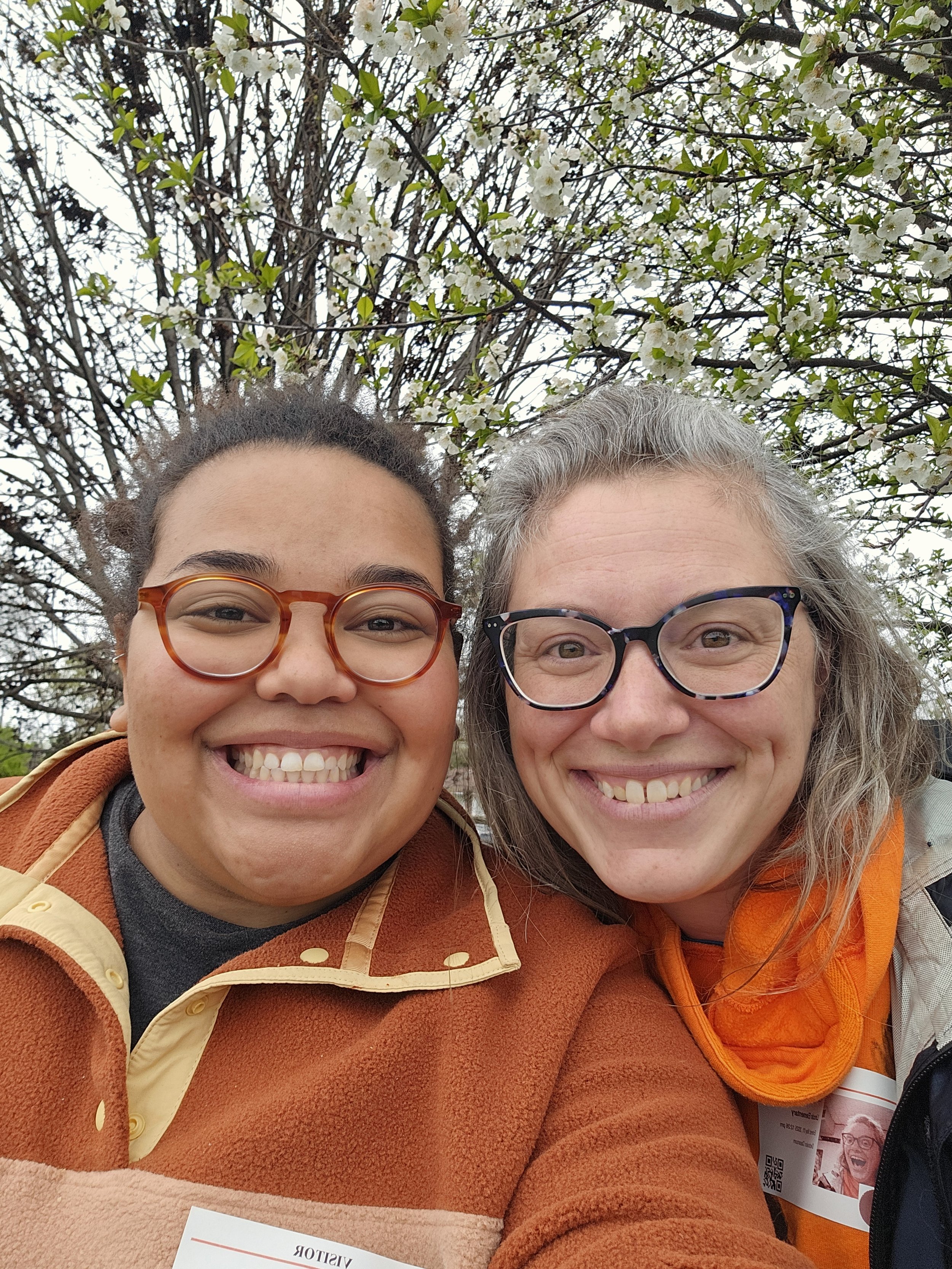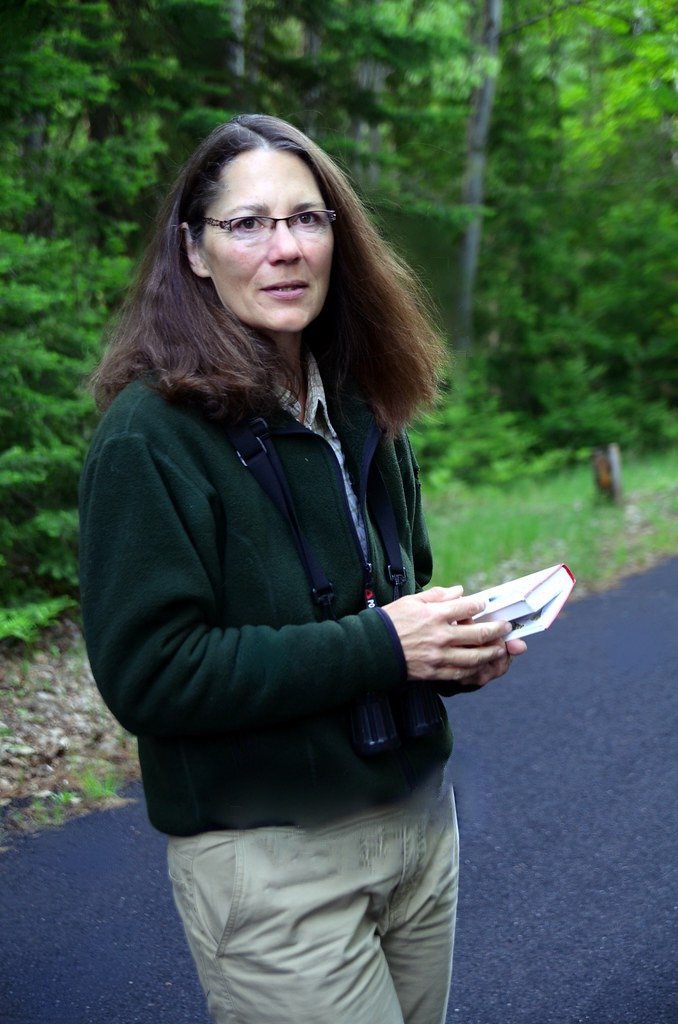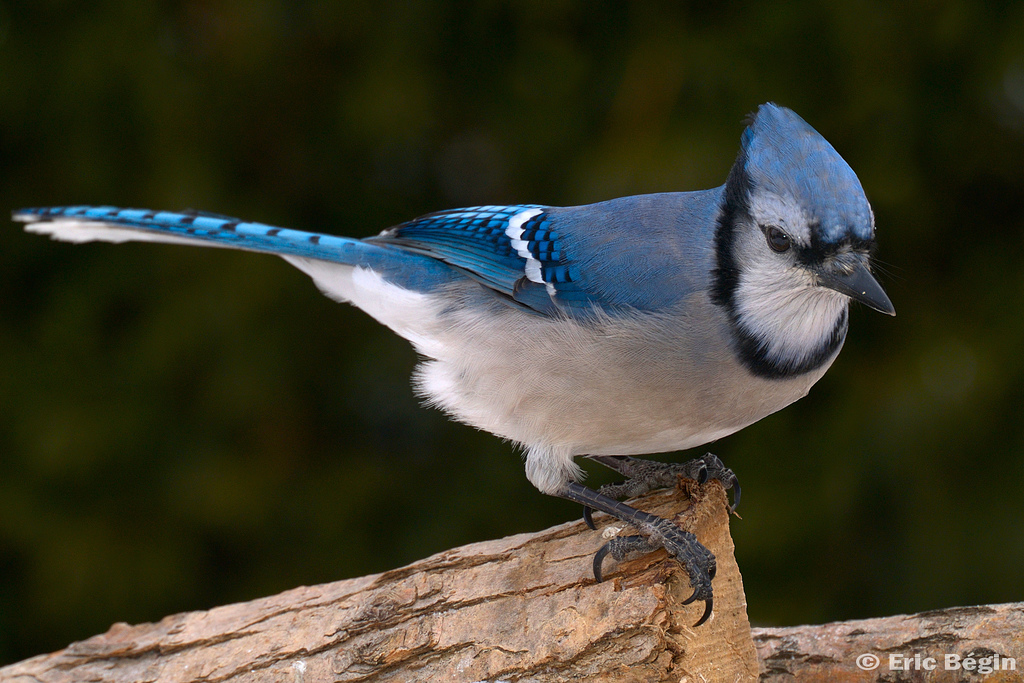Jack Pace (left) and Jackie Sandberg (right) doing rehab work on raptors. (Photos courtesy of Dane County Humane Society. Edit by Adam Putman)
In this episode, we answer questions like “How can we identify hawks when they are flying so high in the sky?“ and learn about hawks use UV vision to their advantage when hunting.
Learn more about the Wildlife Center here!
Subscribe to QuACK on Spotify, iHeart Radio, Apple Podcasts, or your favorite podcast app!
Transcription
Hey, and welcome to Questions Asked by Curious Kids or QuACK, a podcast made by Southern Wisconsin Bird Alliance. This is a podcast where we gather questions about nature from kids to be answered with a local expert. My name is Mickenzee. I'm an educator and I'll be the host for this series. This episode I'll be interviewing Jackie Sandberg and Jack Pace. Jackie is the Wildlife Program Manager at Dane County Humane Society Wildlife Center, and Jack has been a volunteer there for five years and is a master falconer as well. And today we'll be answering questions all about raptors, which are also sometimes called birds of prey. For this episode, we were recording at the Humane Society, so you might hear some funny noises and some furry friends in the background making their voices heard too. Okay, let's jump in with Jackie and Jack.
–----
Mickenzee: Okay, so hey, Jackie and Jack, welcome to the show. This is so special to have two guests to answer questions. And before we get started with the questions from the kids, could you tell us a little bit about what you do at Dane County Humane Society?
Jackie: Yeah, well, I am Jackie Sandberg. I am the Wildlife Program manager for the Humane Society, which has the third largest wildlife program in the state. And what we do is rehabilitate wild animals that are sick or they're injured, or orphaned. And then we kind of like doctors, treat them, make them better, and then hopefully get them back out into the wild to be released. So that's my everyday, all day, every day job.
Mickenzee: Cool, fun. Lots of different animals too. I'm guessing.
Jackie: Oh yeah. Yeah, there's a lot of birds. But we also work with turtles and we work with frogs and snakes and mammals. We have a beaver and two baby bobcats right now and a fox, and it's kind of crazy over here.
Mickenzee: So lots of things. I know a lot of kids would love this job.
Jackie: Oh, yeah. It's a lot of variety.
Mickenzee: Yeah. And what about you?
Jack: My name is Jack Pace. I'm a volunteer with the Humane Society, and my fifth year, I'm a retired police officer and college teacher, and I work with animals because I want to pay back to the animals that I've always loved. And it's a way for me to help them back.
Mickenzee: That's great. And also you. I heard you're a falconer as well.
Jack: Yes. Yes, I am a master falconer. I've been, practicing falconry for over 16 years now.
Mickenzee: Wow. And that's really great, because this episode is all about birds of prey or raptors. And how did the two of you come to like raptors and know a lot about them?
Jackie: I started in my youth. My dad and my grandpa were big into birding, and I will never forget sitting down in my grandpa's house in Kansas, looking over one of the rivers. So the house kind of looked over the Tuttle Creek Boulevard, and eagles would congregate there all the time. So my little, you know, 8 to 10 year old self would sit there with my grandpa and look at his scope and use his old scope from his army days and we’d watch the eagles. So for me, that was what probably set my career path. And then I go birdwatching with my dad. And when I was in high school, we'd go along the Mississippi River and look for waterfowl that were migrating and raptors. And so it was kind of just like a family thing that ended up into a love that turned into a career.
Mickenzee: Wow, that's really great.
Jack: And I've always been an animal person, raised with dogs and cats and now have chickens. And as a teacher, I like teaching, you know, like learning new things and passing that information on. So years ago, when I discovered that you could capture a wild bird and train it and then release it, and it would be smarter and stronger and healthier than when you trapped it, I thought, that's a great way for me to combine all those.
Plus, I'm a pilot and I like anything that flies.
Cooper’s Hawk eating a bird (Photo by Arlene Koziol)
Mickenzee: Yeah, definitely. That's awesome. All of our questions today were submitted by the third graders at Lincoln Elementary School here in Madison. And our first question is, why do hawks sometimes perch on a dead branch to pluck their dinner?
Jackie:So my first thought is that they want to look really good for everybody else that’s looking at them. I don’t know if that's true. Just to show off that they've got something really cool, that's my first thought. I don't know if that's actually true, but I do know that when I've watched, raptors out in the wild catch prey and, have on a dead branch one of my favorites was a Red-Tailed Hawk that I was tracking for my graduate school degree. And he caught a frog, which I thought was pretty surprising.
Mickenzee: Yeah.
Jackie: And I watched him eat it on this dead branch, and he was just so excited. He had just had it in his talons, stuck against the branch, and he was just using that sharp beak to pull off different pieces. And I just thought that it was pretty amazing. And I thought, well, that would be pretty messy if you were in a, you know, bush or on the ground, they sometimes will eat off the ground too. But, you know, I thought that maybe those branches offered them a way to be able to perch on there with their food and then easily shear off the pieces.
Mickenzee: Oh, definitely.
Jackie: So I think that might be a good reason, and it might be an easy landing spot. You know, a nice big bare branch up high depending on what kind of species it is, to be able to effectively eat their food and look for other predators or other animals that might try to, you know, steal their food. So maybe just having a big open space for a watchful eye, that's usually what I think of.
Jack: Yeah. And the other thing I could add to that is just reinforce the idea that, they don't like to eat on the ground because it's very dangerous for them. And so they like to fly away with anything they can carry. And if, if they're carrying something heavy, using this place to land is on a dead branch, not a one full of leaves. And because of their eyesight, is so strong. It's a defense mechanism where they need to see what's going on around them. Because it's not uncommon for one raptor to steal the food of another.
Mickenzee: Yeah.
Jack: So they're always watchful for that.
Mickenzee: Yeah. Our next question is how do hawks and falcons hunt.
American Kestrel that caught a dragonfly (Photo by USFWS)
Jackie: Ooh they are all very different. So I might defer to Jack on this one because he has worked with lots of other species and we work with some here. But I know vision is a big one. They hunt using their eyes. But also I know some species like kestrels will follow, urine tracks in grass the they can see UV light where. So it highlights where those little mouse trails are. And so if they're looking for something, they might be able to follow the way that they can see the UV light shining with the, the urine trails from mice. You know, that could be one
Mickenzee: That's so interesting.
Jackie: Yeah. Isn’t it cool? Some eating fish. Obviously you have to dive really fast to catch a fish, but, how about any of your birds?
Northern Harrier’s have a round facial disk of feathers similar to owls for hearing their prey (Photo by Mick Thompson)
Northern Harrier flying low, listening and looking for prey (Photo by Andy Reago and Chrissy McClarren)
Jack: Well, as far as, hawks go, most hawks like to perch, and they use their eyes to watch for something to, eat and then they go after it. Falcons like to fly, and they catch birds in the air and usually very fast. And then there, there's a hawk called the Northern Harrier that actually has owl rings around its eyes. The face looks like an owl because it focuses sound into their ears and they fly or they hunt by sound like flying very slowly over marsh land. And then when they hear a sound, they go get it.I think they're the only raptor that nests on the ground also.
Mickenzee: Wow.
Jackie: Snowy owls. If you go into the owl region, kind of they might on crags of rocks and like, if you're, like an Iceland, I know they do sometimes nest on the ground, but I agree, I think harriers are one of the only other ones I know that do that.
Mickenzee: Oh cool.
Jackie: They also have those really sharp talons. I know that the the digits on their feet. So we think of us having five toes. Well we think of the three forward facing toes and the one back toe for our hawks. That back toe is really, really sharp and strong. And there's a tendon that goes along the base end of the leg so that when they grab their prey, they have such a strong grip that the prey can't let go. So that's another like really cool adaptation the Raptors have.
Bald Eagle coming in for a landing. Look at those sharp talons! (Photo by Arlene Koziol)
Mickenzee: They kind of lock in.
Jackie: Yeah. So that's effective way to hunt.
Mickenzee: Definitely, definitely. Cool. So the all different hawks use different senses for their hunting different strategies. That's interesting.
Jackie:Yeah.
Mickenzee: And then lastly this question asker submitted. My class was outside walking and we saw two hawks flying up really high. How can we identify hawks when they're flying up in the air?
Red-tailed Hawk soaring (Photo by USFWS)
Northern Harrier Silhouette (Photo by USFWS)
Fast flapping Merlin (Photo by Andy Reago and Chrissy McClarren)
Jackie: I remember being taught that it was based on their size and their silhouette, and also sometimes just thinking about the environment you're living in. There might not be, Northern Harrier who lives in a marsh. If you're in a downtown area, in an urban space, you're not going to find a Northern Harrier there. So you can kind of use process of elimination based on where you are bird watching. But the silhouette of the bird, if you're looking up towards the sky, it might just look like a little black speck. But if you watch what they're doing, you know, are they soaring in a big circle like they're soaring a thermal, which is the heat rising from the ground? That might be a beauteo. So it might be a couple of hawk species. It could be a Broad-winged hawk, it could be a Red-tailed Hawk. I know that some birds like to flap more than others. So, one of my favorites, friend of mine, Eric Burkey up north, works at Hawk Ridge, up near Duluth. And they do a lot of hawk banding and trapping up there. And, my favorite one from him is Merlins. Being late for a date, I mean that they are flapping as fast as they possibly can. And so it's kind of funny. You kind of learn these little tips along the way of how they fly, you know, how fast are the wing beats, how angular are the wing beats? How does the silhouette look against the sky with the sun out? And what size are they? Those are all the things that I know that I've used to try to figure out which kind of raptor it is.
Jack: Yeah. And that's a little bit more than I understand. I primarily use if they’re way high the shape of the wings and size of the wings. Because all the raptors have different shapes to their wings and the tail.
Jackie: Oh, yeah.
Jack: Sometimes tails are long and sometimes they're short and sometimes are wide open and sometimes they’re invisible. And then once you learn all of those things, you can really narrow it down. When they're closer. I use, those same attributes. But I also go with color. Certain birds have a certain color in a certain spot.
Mickenzee: Yeah. And so like a Red-tailed Hawk, you usually can see that that rusty orange tail.
Turkey Vulture displaying V-shape and bald head (Photo by Mick Thompson)
Jack: Exactly.
Mickenzee: Or I think of, like, Turkey Vultures super tippy in the air.
Jackie: Yeah, yeah. Nice. V.
Jack: Yeah, they got a v and they got that bald head.
Jackie: Yeah. It's. Which is a really cool thing. I have learned a lot about turkey vultures over the years. So that bald head is great for, you know, being able to eat food that is a carcass on the ground and not have all of their feathers stuck with food. So it's bald on purpose so that they stay cleaner.
Mickenzee: Definitely cool stuff.
Jack: Yeah. And that reminds me, when we go back to how raptors hunt turkey vultures hunt primarily by their nose.
Jackie: Yes. That's true.
Mickenzee: And that's not super common among birds, right?
Jackie: No, there's more to be studied there, I think. But with vultures, they know that within miles, I want to say up to even six miles away, they can smell some carcass of an animal. And because they can help us in a really cool, we call it ecosystem services, that they're cleaning up all the dead carcasses on the side of the road for us because they can eat it, and then they don't have issues too much with disease or bacteria overgrowth, and they're just adapted to eat all the stuff that we don't really want to touch. I think that's pretty awesome.
Mickenzee: Thank you. Turkey vultures. Well, raptors are so amazing. I feel like I learned a ton today and got a new appreciation for these birds. Thank you. Third graders at Lincoln Elementary for submitting these big questions. And thank you, Jackie and Jack for coming in to teach us today.
Jackie: Thanks for having us.
Jack: You’re welcome, Thank you.
-----
If you are interested in learning more about raptors or getting involved with our programs, please head to our website at swibirds.org and check out the free lessons, games and activities like Owl Eyes and Bird Adaptations. You can also sign up for things like Bald Eagle Nest Watch, Kestrel Nest Box monitoring, or Bird Collision Corp.
If you have a big nature question that you'd like to have answered, please have a grown up or your teacher submit your questions to info@birds.org with the title Questions for QuACK. Make sure to include your grade and the school you attend so I can give you a shout out on the show. Thanks for tuning in and I hope you join us next time on QuACK!
Check out SoWBA’s free lessons, games, and activities!
Get out and explore nature with us!
Make a donation to Southern Wisconsin Bird Alliance
Audio Editing and Transcription by Mickenzee Okon
Logo design by Carolyn Byers and Kaitlin Svabek
Music: “The Forest and the Trees” by Kevin MacLeod











































